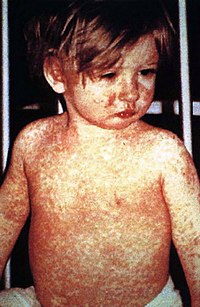
Photo from wikipedia
Mature adipocytes that accumulate during obesity inhibit host defense against infection by feedback suppression of dermal adipocyte progenitors. An obesity-infection connection Obesity is known to increase the risk of skin… Click to show full abstract
Mature adipocytes that accumulate during obesity inhibit host defense against infection by feedback suppression of dermal adipocyte progenitors. An obesity-infection connection Obesity is known to increase the risk of skin infection. Zhang et al. show that increased numbers of mature adipocytes in a mouse model of diet-induced obesity led to increased TGFβ signaling, which in turn reduced the abundance of dermal adipocyte progenitors. The remaining progenitors produced insufficient amounts of the antimicrobial peptide cathelicidin, thereby predisposing the obese mice to skin infection by Staphylococcus aureus. The PPARγ agonist rosiglitazone or a TGFβ receptor inhibitor restored the ability of the obese mice to defend against infection. As dermal adipocyte progenitors were also reduced in obese individuals, targeting TGFβ signalling may have clinical potential. Infections are a major complication of obesity, but the mechanisms responsible for impaired defense against microbes are not well understood. Here, we found that adipocyte progenitors were lost from the dermis during diet-induced obesity (DIO) in humans and mice. The loss of adipogenic fibroblasts from mice resulted in less antimicrobial peptide production and greatly increased susceptibility to Staphylococcus aureus infection. The decrease in adipocyte progenitors in DIO mice was explained by expression of transforming growth factor–β (TGFβ) by mature adipocytes that then inhibited adipocyte progenitors and the production of cathelicidin in vitro. Administration of a TGFβ receptor inhibitor or a peroxisome proliferator–activated receptor–γ agonist reversed this inhibition in both cultured adipocyte progenitors and in mice and subsequently restored the capacity of obese mice to defend against S. aureus skin infection. Together, these results explain how obesity promotes dysfunction of the antimicrobial function of reactive dermal adipogenesis and identifies potential therapeutic targets to manage skin infection associated with obesity.
Journal Title: Science Translational Medicine
Year Published: 2021
Link to full text (if available)
Share on Social Media: Sign Up to like & get
recommendations!